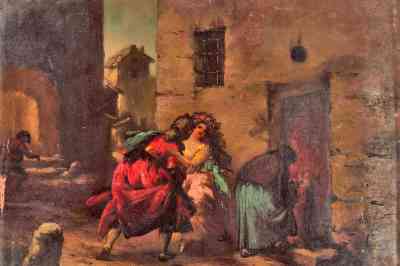News:
Scores of paintings in Madrid’s Prado Museum were seized during Franco era
By Isambard Wilkinson, Madrid
The Prado Museum in Madrid has identified 70 artworks in its collection that were seized during the Spanish Civil War and the dictatorship of General Franco.
The discoveries were made during an investigation into the provenance of works seized during the 1936 to 1939 conflict, with the aim of restoring them to their rightful owners.
The investigation, which was instigated as part of the museum’s reckoning with its wartime legacy, has uncovered the provenance of ten of the paintings, providing names and surnames or a concrete origin.
Escena de majos y celestina, attributed to Eugenio Lucas Villaamil, was among the works identified
Arturo Colorado Castellary, an expert on cultural heritage and the Spanish Civil War, who led the study, said it was “important to differentiate clearly between those sent to be safeguarded in the storerooms of the Prado and the Museo de Arte Moderno by the Republican Committee for the Artistic Heritage during the war, and those sent on deposit to the two museums by the Francoist Service for the Defence of the National Artistic Heritage in the postwar period”. Of the 70 works, more than half were seized by Francoist forces.
Among the original owners of the works identified by Colorado’s study are Pedro Rico, mayor of Madrid on two occasions (1931-34 and 1936), a church at Yebes, Guadalajara, and the Marquis of Villalonga. A work that belonged to Rico was Escena de majos y celestina, a painting attributed to Eugenio Lucas Villaamil.
Two further works have been traced to exact addresses although the owners’ names are not known. The museum noted that many artefacts from the period had not been returned to their owners “because they could not prove ownership, had died, were in exile, were the subject of reprisals or were simply unknown as they failed to include their names on the requisition documents”.
“Misinformation increased in the postwar period, due to the large number of works that the Francoist Service had to manage and the decision not to investigate those origins but simply hand them over to other recipients,” the report said.
The investigation concluded that “during the postwar period, the Francoist Service . . . deployed a policy of massive diversion of works of art to different destinations. In some cases, because the origin of the pieces was unknown, but in many others because they belonged to collections of political enemies or simply to benefit institutions or supporters of the regime”.
Colorado’s study made clear that the main beneficiaries were museums, which received more than 3,000 works, followed by public bodies, with 2,000, and the church, with a similar figure. Some 600 pieces ended up in the hands of individuals. It adds: “The post-Franco war years represented the largest diaspora of works of art in the history of our country, with a relocation of thousands of works, if not their disappearance.”


